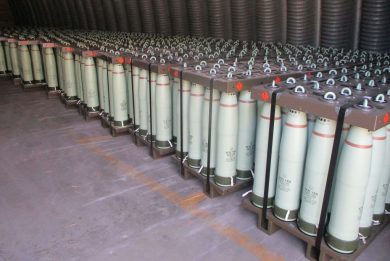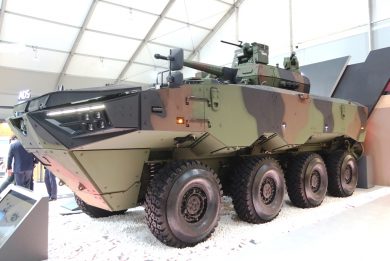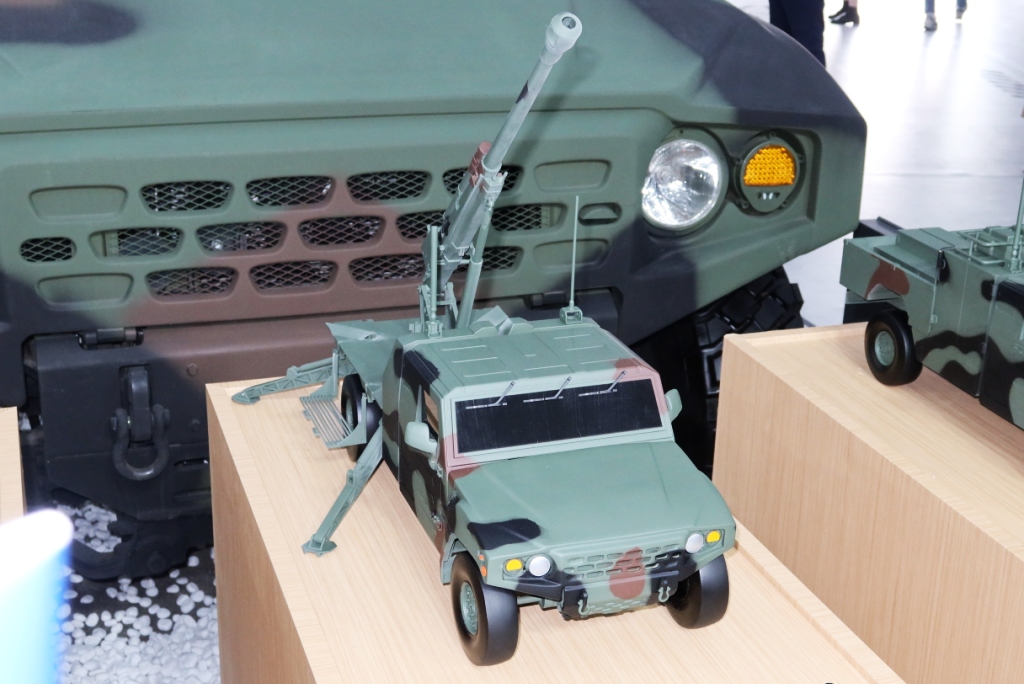
ADEX 2023 – Airmobile indirect firepower courtesy of Hyundai WIA
At ADEX 2023 Hyundai WIA, the armament branch of the holding, unveiled its indirect fire applications for airmobile troops, consisting of an 81 mm mortar and a 105 mm howitzer, both mounted on a light armoured 4×4 vehicle
The need to quickly redeploy forces in a country which 70% surface is made of mountains makes airmobility a key issue. Transporting military assets undersling using heavy helicopters adds a degree of freedom to military planners. While moving personnel is relatively simple, moving heavier assets such as indirect fire systems is another story, especially if we want to couple firepower with mobility.
To answer the Republic of Korea Army (ROKA) requirements, Hyundai WIA teamed with some other Korean companies to develop two airmobile solutions, one dedicated to infantry and one to artillery, that will allow ROKA light units to deploy with the close support of organic indirect fire systems both mounted on a modified KIA K351 KLTV (Korea Light Tactical Vehicle) 4×4 light armoured vehicle in the long chassis version, one being an 81 mm while the second is a 105 mm howitzer.
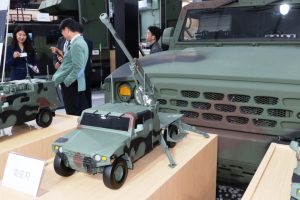
Starting from the latter, Hyundai WIA took the existing KH178 105/37 mm gun and modified it in order to install it on the rear of the pick-up version while adding a hydro-pneumatic damping system able to reduce recoil forces. Four hydraulically operated outriggers are however required when firing. Traverse and elevation actuators are electric, as well as the trigger system. The crew of two, section leader and gunner, is hosted in the front armoured cabin, the commander’s post being fitted with the fire control computer and display, an auxiliary power supply being fitted, while the vehicle features an inertial/satellite navigation system. The elevation arc is -5°/+65°while traverse is ±135° from the rear. Range is 14.7 km with HE and 18 km with RAP rounds. EDR On-Line understood that Hyundai WIA has optimised the gun, therefore some marginal increase in range might have been obtained.
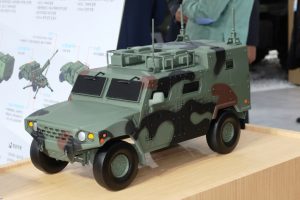
Two other vehicles complete the system, an ammunition carrier also on a modified K351, able to transport up to 40 rounds and a similar number of fuses. Its crew is also made of two military, the ammunition bearer and the gunner. Finally comes the fire command vehicle, which has the most numerous crew, being the only vehicle which is not in pick-up configuration. The protected cabin has four access doors, a small shelter at the back hosting working space and equipment. Here the commander, the fire controller and the radio operator ensure the liaison with the higher echelon and provide the gun leader with the firing data. This vehicle is fitted with the BTCS 1 (Battalion Tactical Command System) provided by LIG Nex1; it is also equipped with the B2CS (Battalion Battle Command System) and with the TMMRs (Tactical Multi-band, Multi-role Radio), also by LIG Nex1, those two systems being fitted also to the gun and the ammo vehicles.
The 105 mm airmobile solution is still in the development phase, therefore only models of the three vehicles were visible at the Seoul exhibition, the completion of the programme being planned for May 2025..
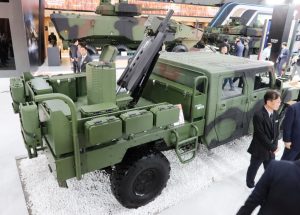
Things were different for the 81 mm mortar, which prototype could be seen at ADEX. The automatic laying mortar system is installed at the rear, with free traverse over 360° at a speed of 20°/s, the elevation arc being +45°/+85°, with an angular speed of 10°/s. Thanks to the recoil damping system adopted, the mortar vehicle does not need any outrigger for stabilisation. Loading is manual, 80 rounds being available in the case at the back of the cabin. At the rear of the flatbed an armament control system hosts the controller, the power supply system and the firing data display; mortar laying can be automatic, semi-automatic or manual. The vehicle is equipped with a Geonyx SP inertial navigation system and a MAT-743 GPS receiver. The vehicle combat mass is 7 tonnes, the maximum allowed according to ROKA airmobility requirements, the same mass being that of the artillery gun and ammunition vehicles previously described, while the artillery command post is lighter, 5.3 tonnes. With the prototype ready, Hyundai WIA aims at completing the system development in August 2024. Beside the systems proposed to the ROKA based on in service vehicles for obvious logistic reasons, the company is ready to integrate its mortar and artillery low recoil solutions on other platforms, according to customers’ needs, as it looks confidently also at the export market,
Photos by P. Valpolini

